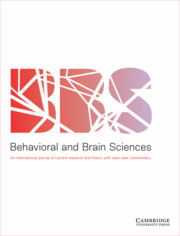Article contents
The Now-or-Never bottleneck: A fundamental constraint on language
Published online by Cambridge University Press: 14 April 2015
Abstract
Memory is fleeting. New material rapidly obliterates previous material. How, then, can the brain deal successfully with the continual deluge of linguistic input? We argue that, to deal with this “Now-or-Never” bottleneck, the brain must compress and recode linguistic input as rapidly as possible. This observation has strong implications for the nature of language processing: (1) the language system must “eagerly” recode and compress linguistic input; (2) as the bottleneck recurs at each new representational level, the language system must build a multilevel linguistic representation; and (3) the language system must deploy all available information predictively to ensure that local linguistic ambiguities are dealt with “Right-First-Time”; once the original input is lost, there is no way for the language system to recover. This is “Chunk-and-Pass” processing. Similarly, language learning must also occur in the here and now, which implies that language acquisition is learning to process, rather than inducing, a grammar. Moreover, this perspective provides a cognitive foundation for grammaticalization and other aspects of language change. Chunk-and-Pass processing also helps explain a variety of core properties of language, including its multilevel representational structure and duality of patterning. This approach promises to create a direct relationship between psycholinguistics and linguistic theory. More generally, we outline a framework within which to integrate often disconnected inquiries into language processing, language acquisition, and language change and evolution.
Keywords
Information
- Type
- Target Article
- Information
- Copyright
- Copyright © Cambridge University Press 2016
References
- 364
- Cited by



Target article
The Now-or-Never bottleneck: A fundamental constraint on language
Related commentaries (28)
Better late than Now-or-Never: The case of interactive repair phenomena
Conceptual short-term memory (CSTM) supports core claims of Christiansen and Chater
Consequences of the Now-or-Never bottleneck for signed versus spoken languages
Exploring some edges: Chunk-and-Pass processing at the very beginning, across representations, and on to action
Gestalt-like representations hijack Chunk-and-Pass processing
How long is now? The multiple timescales of language processing
Is Now-or-Never language processing good enough?
Language acquisition is model-based rather than model-free
Language processing is not a race against time
Linguistic representations and memory architectures: The devil is in the details
Linguistic structure emerges through the interaction of memory constraints and communicative pressures
Linguistics, cognitive psychology, and the Now-or-Never bottleneck
Many important language universals are not reducible to processing or cognition
Mechanisms for interaction: Syntax as procedures for online interactive meaning building
Memory limitations and chunking are variable and cannot explain language structure
Natural language processing and the Now-or-Never bottleneck
Neural constraints and flexibility in language processing
Now or … later: Perceptual data are not immediately forgotten during language processing
On the generalizability of the Chunk-and-Pass processing approach: Perspectives from language acquisition and music
Pro and con: Internal speech and the evolution of complex language
Processing cost and its consequences
Realizing the Now-or-Never bottleneck and Chunk-and-Pass processing with Item-Order-Rank working memories and masking field chunking networks
Reservoir computing and the Sooner-is-Better bottleneck
Socio-demographic influences on language structure and change: Not all learners are the same
The bottleneck may be the solution, not the problem
The ideomotor recycling theory for language
What gets passed in “Chunk-and-Pass” processing? A predictive processing solution to the Now-or-Never bottleneck
“Process and perish” or multiple buffers with push-down stacks?
Author response
Squeezing through the Now-or-Never bottleneck: Reconnecting language processing, acquisition, change, and structure